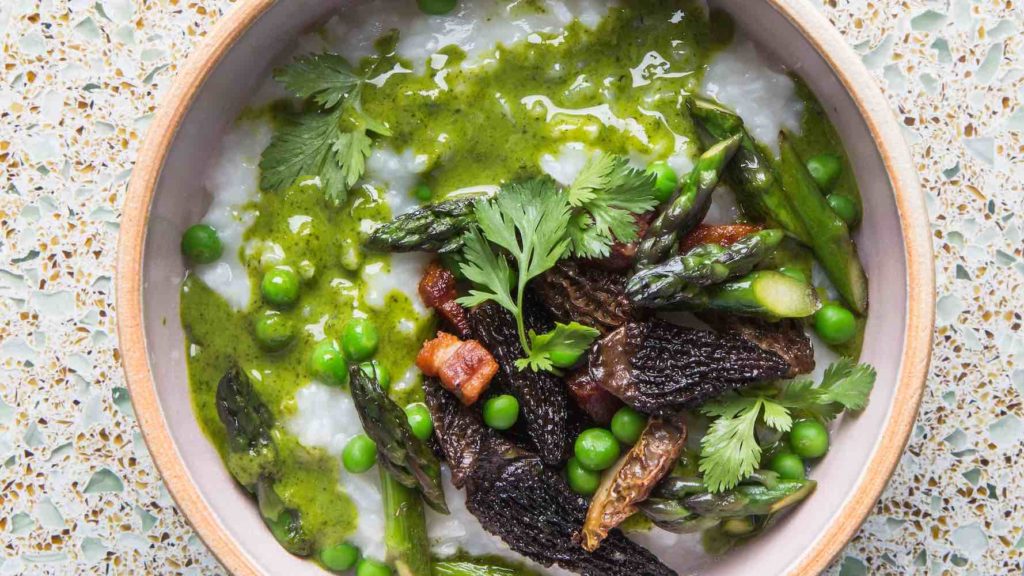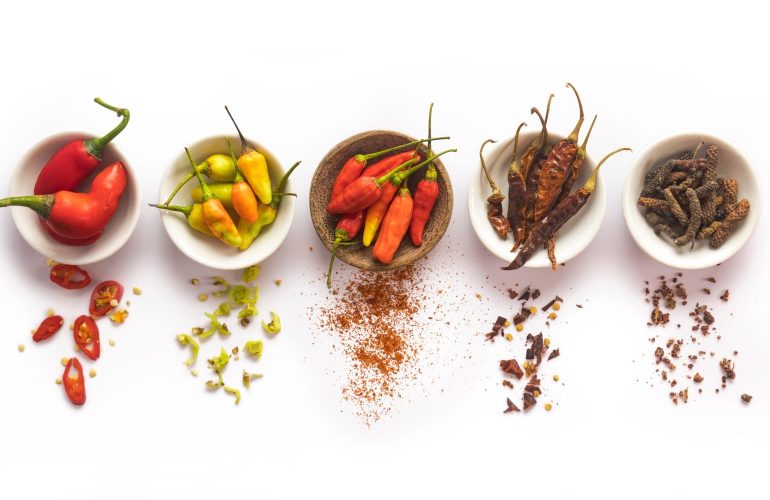Some like it hot, some don’t. Spicy foods elicit strong responses from both camps. According to Ayurvedic nutrition theory, spicy (aka pungent) foods can be very beneficial for some and aggravating for others. On the other hand, yoga philosophy encourages sattvic (harmonious, pure, light, calming) living and discourages foods that are seen as rajasic (active, heating, forceful, piercing, stimulating). So what is an Ayurvedic yogi to do? The classic answer in Ayurveda is, “It depends.” Let’s look at the qualities of pungent foods and spices to get a better understanding of their possible benefits and caveats.
We know from my earlier post on the six tastes of Ayurveda that katu, or the pungent flavor, contains the elements of fire and air. It is said to balance the heavy wetness of the earth and water elements of kapha dosha and bring much-needed heat to the cold air and space elements of vata dosha. However, for people who are predominantly pitta dosha (ruled by fire), pungent foods can be aggravating, as they create too much dispersing heat. When used in moderation, it can strengthen digestion for vata and kapha dominant people.
For earthy-watery types with a predominance of mucus, phlegm, respiratory issues, and sluggish digestion, the spicy taste helps to move congestion, dry mucus, phlegm, and ama (toxins) out of the system. For vata folks, the digestive stimulation, boost in circulation, and warming are incredibly helpful but too much of a good thing can lead to dryness and aggravation. A little goes a long way. Pungent foods and spices are known to help improve circulation, thin the blood, improve elimination, and help to remove parasites and worms from the digestive system. All helpful when used in small amounts, as needed. For fiery folks, too much spicy food aggravates the esophagus and stomach lining. For many, it leads to the not so fun experiences of diarrhea, heartburn, acid reflux, excessive sweating, and nausea.
Besides the physical effects of the pungent taste, Ayurveda describes its psychological states. A little spice in food and drink can bring enthusiasm, vitality, clarity, and strength. It is said to lead to inquiry, insight, and a boost in concentration, helping the mind focus and increase determination. These qualities are especially beneficial for both vata and kapha dominant people. Since these qualities are inherent in the fire type of pitta dosha, they can actually lead to more intensity, irritability, competitiveness, and anger. That doesn’t mean fire types can’t enjoy and even benefit from a little pungent taste now and then, but they should practice awareness of their overall health and moderation, as always,or at least have antidotes handy. Licorice, dates, fennel, and coconut are all excellent antidotes for too much pungent taste.
Now, of course, while some people are very much ruled by one dosha (their main constitution), many people, myself included, are dual dosha. In general, we want to pay attention to the seasons, limiting spicy foods in the hot summer months. Autumn, winter, and spring are the times to spice up your foods and drinks a little more. Remember, we always want to incorporate all six tastes into our daily meals, and there are many ways to do that. Some examples of pungent flavors are common spices, such as cayenne pepper, black pepper, chilis, mustard seed, dry and fresh ginger, and asafetida. Common spicy foods are chili peppers, hot sauces, radishes (including horseradish and wasabi), garlic, all onions (including ramps and chives), all mustard greens, and kohlrabi. Cooking techniques will affect the pungency of these spices and foods. Roasting spicy vegetables caramelizes the carbohydrates, enhancing the sweet flavor to bring balance. Steaming and boiling also reduces spiciness. Eating these spices and foods raw is the most potent way to experience the true fire within them.
Overall, enjoy a little kick in your diet and teas by adding ginger, mustard greens, radishes, and black pepper to spring menus to give your immune and digestive systems a nice boost. Below is a favorite recipe of mine to clear any excess heaviness or dampness from the digestive system and support overall immunity. Most of the ingredients are available in your local markets and any type of dark leafy green can be used. Make a big pot of the rice congee to enjoy for a hearty and healthy breakfast as well.
Spicy Spring Greens with Roasted Radish and Turnips Recipe
Ingredients
1 bunch turnip greens, chopped
1 bunch mustard greens, chopped
1 large white onion, sliced thin
2 garlic cloves, minced
1 bunch radish, topped
1 bunch small turnips, cut in half or quarters
1 inch piece of ginger, chopped
2 tbsp olive oil
1 tbsp champagne vinegar
1 to 1 ½ tsp sea salt
1 tsp black pepper
Directions
- Preheat oven to 400 degrees. Line a baking sheet with parchment paper, toss radishes and turnips in 1 tbsp of olive oil, as well as a pinch of sea salt and black pepper.
- Spread evenly on the baking sheet, and cook about 20-25 minutes until tender.
- While the roots are roasting, heat a large saute pan on medium-high. Add 1 tbsp olive oil and onions, cooking about 5 minutes until translucent. Stir often.
- Add garlic, ginger, and greens. Reduce heat to medium-low and cover. Cook for another 3-5 minutes.
- Add vinegar, salt, and pepper to taste, and enjoy over ginger congee.

Ginger Congee Recipe
Ingredients
2 cups white sushi or Jasmine rice, rinsed until water is clear
3 cups filtered water
1 tsp sea salt
1 ½ tbsp grated fresh ginger
1 tbsp white wine vinegar or mirin
1 tbsp chopped cilantro
Directions
If you have a rice cooker, you can place all ingredients into the pot at once, hit the “rice” function, and prepare the rest of the meal. If not, take a medium-sized pot, add the ingredients into the pot, and bring to a boil. Reduce to simmer and cover. Let cook for 20-25 minutes until rice is cooked and liquid is absorbed. Sprinkle with chopped cilantro, and enjoy.












